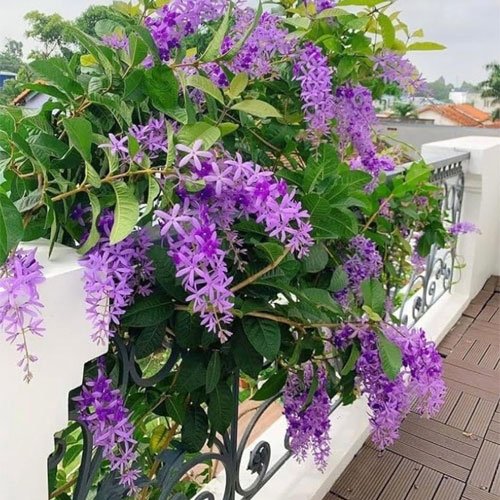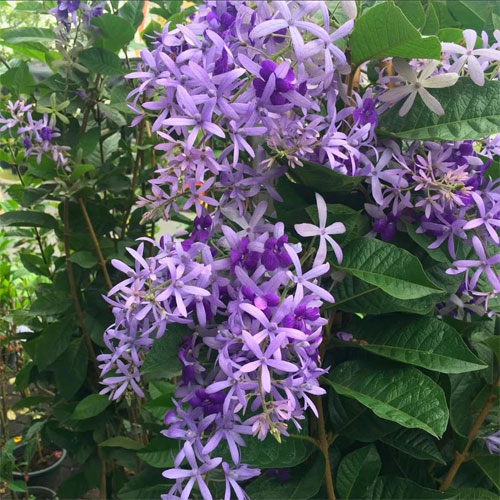Enhance your garden with the Petrea Blue Flowering Creeper Live Plant, also known as Queen's Wreath or Blue Sandpaper Vine. This fast-growing ornamental climber is loved for its cascade of violet-blue star-shaped flowers, resembling the beauty of wisteria. Perfect for balconies, arches, fences, and trellises, Petrea adds a touch of tropical elegance to any home or garden.
Its name ‘Sandpaper Vine’ comes from its rough-textured leaves. The flowers bloom in long, drooping sprays that attract butterflies and garden lovers alike. A must-have for gardeners looking to create a vertical floral display with minimal effort.
Type of Plant: Flowering Ornamental Creeper (Petrea volubilis – Blue variety)
Germination Time: Not applicable (live plant)
Hours of Sunlight Needed: 5–6 hours of bright indirect or partial sunlight
Where to Grow: Compound walls, trellises, fences, balconies, pergolas
Growing Season: Year-round planting in warm climates
Seed Sowing Depth: Not applicable
Ideal Climate: Tropical and sub-tropical regions
Plant Height: Up to 15–20 feet with support (delivered at 1 to 2 feet)
Organic Fertilizer Requirements: Compost, bone meal monthly
Life Span: Perennial
Ideal Growing Temperature: 22°C to 35°C
Blooming Time: Primarily Spring & Summer (can bloom twice a year)
Maintenance Required: Low to moderate
Watering Frequency: 2–3 times a week or when topsoil dries
Ideal Grow Bag Size: 18×18 inch grow bag or large pot with trellis



Petrea thrives throughout India, especially in tropical states. Best growth occurs when planted from January to September, giving enough time for root development before flowering begins. Flowers appear in spring and summer, and with proper care, it may bloom again in late monsoon or early winter.
Choose a large grow bag or pot with proper drainage. Fill with well-draining soil mixed with compost and cocopeat. Provide a strong trellis or wall for the creeper to climb. Keep in partial to full sunlight and water when the topsoil feels dry. Monthly feeding with organic flower boosters will enhance blooming.
Not applicable – this is a live flowering plant, not grown from seed.
Sunlight: Requires bright indirect sunlight or partial sun
Soil: Use loose, organic-rich, well-draining soil
Fertilization: Add compost or phosphorus-rich fertilizer monthly
Pruning: Trim after flowering to encourage new growth and shape
Support & Spacing: Must be trained on trellis or fence
Pest Control: Rarely attacked; use neem spray if needed
Disease Prevention: Prevent water stagnation to avoid root rot
Mulching: Helps retain moisture during summer
Harvesting: Flowers can be cut for decoration; non-edible plant
1. Apply Nutrient-Rich Fertilizers
When your plants begin flowering, use nutrient-rich fertilizers like Organic Bone Meal Powder or Vermicompost. This helps in boosting the bloom and enhances overall yield.
2. Use Organic Fertilizers
Feed your plants with organic fertilizers such as Cow Dung Manure or Neem Cake. Organic options promote healthy soil life.
3. Regular Feeding
Apply fertilizers every 20-25 days to ensure plants receive a steady supply of nutrients. Choose from various options like Cocopeat Compost for moisture retention.
Produces stunning violet-blue cascading flower sprays
Star-shaped blooms resemble wisteria and last for weeks
Leaves are textured like sandpaper, adding a tropical look
Attracts butterflies and pollinators, ideal for eco-friendly gardens
Fast-growing, suitable for arches, railings, and pergolas
Once established, it becomes drought-tolerant and easy to maintain
Excellent for creating floral curtains on fences and pergolas
Adds vertical interest to balconies and garden spaces
Perfect gift plant for housewarmings or landscaping lovers
Low-maintenance creeper with long blooming cycles
Great for creating privacy walls with flowering beauty
Avoid heavy shade as it reduces flowering. Do not overwater or let roots sit in soggy soil. Tie growing shoots gently to the support structure. If planted in a small pot, repot annually to prevent root binding. Protect from frost in extreme northern climates by covering or shifting indoors.
Yellowing Leaves: Overwatering – allow topsoil to dry before watering.
No Flowering: Caused by poor light or lack of fertilizer – provide 5+ hrs sun and feed monthly.
Slow Growth: Enrich soil with compost or repot in fresh soil.
Pests: Rare but can get mealybugs – spray with neem oil diluted in water.
Petrea Blue, Queen’s Wreath, Blue Sandpaper Vine, Neel Chandni Valli, Neela Petrea Climber, Neela Malli Valli, Butterfly Creeper, Royal Blue Hanging Flower Plant, Valarpachilai Valli, Blue Wisteria Vine, Nilamalli, Blue Gokarna
Q1. Will it flower in the first year?
Yes, if sunlight and feeding are proper, it can bloom in the first season itself.
Q2. Can I grow Petrea Blue in a hanging pot?
No, it needs vertical support like a trellis or arch for proper growth.
Q3. Are these flowers fragrant?
Slightly. The main appeal is visual – long-lasting violet-blue clusters.
Q4. Does it attract bees and butterflies?
Yes. It is a butterfly magnet and supports pollination in gardens.
Q5. Can it grow indoors?
Not recommended unless you have bright filtered light near a window and space for climbing.
Sign in now to receive a 5% instant discount on your first order when using code WELCOME. Begin your organic journey today!
By logging in, you're agreeing to our Terms of Service and Privacy Policy.
Aarav Deshmukh
Plant ka color aur growth dono excellent. Daily watering aur sunlight me aur lush ho gaya.
Rohini Sen
Bahut satisfied hu. Plant fresh aur ready to grow stage me tha. Garden me ek new charm add kar diya. 🌼
Pallavi Gupta
Healthy aur fast growing creeper. Rare color aur easy maintenance. Loved it!
Mithun Varma
Golden Hills Farm ke products trusted hain. Blue flowers daily khil rahe hain ab. 💙
Asha Joseph
Plant safe packaging me aaya aur koi damage nahi. Support wire pe chadhte hue beautiful lagta hai.
Rajesh Dutta
Creeper well rooted aur pest-free mila. Full sunlight me aur better grow kar raha hai. 🌿
Sushma Pillai
Roots healthy aur soil moist thi. Flowers ka violet blue color garden me charm add karta hai. 🌸
Ankit Chauhan
Bahut fast growing creeper. Balcony railing ke liye perfect. Quality 10/10.
Rekha Iyer
Packaging safe thi aur pot ready condition me aaya. Blue color ka creeper dekh kar sab khush ho gaye. 💐
Sunil Sharma
Plant thoda small tha but fresh aur alive. Water karne ke baad new leaves nikal aaye. 🌿